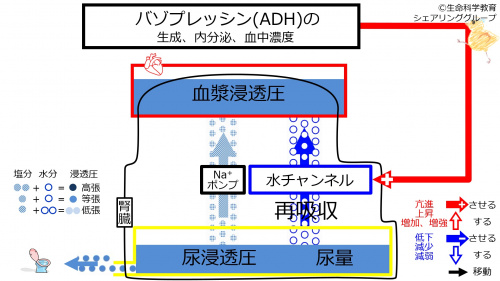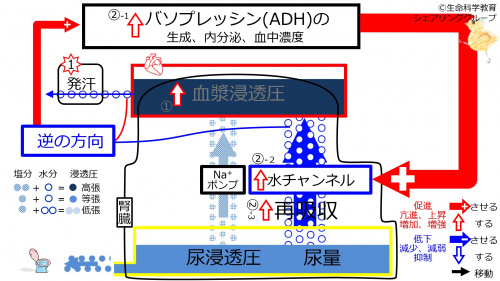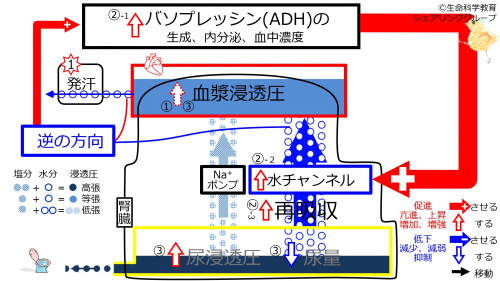SHolroydAtWeilCornellMedQatar/Endocrinology/VasopressinADH/ControlToSweating
| Sweating will increase plasma osmolarity. This will in turn lead to a increase in the synthesis, secretion and blood concentration of ADH. |
発汗前の動画
Prior to sweating we assume our subject is in homeostasis with normal plasma and urine osmolarities and volumes.
発汗直後、調節前の動画
Steps 1 and 2: The subject sweated. Water will leave the plasma and its osmolarity will increase. Sweating will increase and the ADH/water channels/reabsorption of water by the kidney will decrease plasma osmolarity, having the opposite effect. Thus, in this case with high plasma osmolarity, the effect of ADH/water channels/reabsorption would be too little.
発汗に対してADHが亢進した直後の動画
Steps 3 and 4: With too little effect of ADH/water channels/reabsorption, the negative feedback increases (the synthesis, secretion, and blood concentration of) ADH. The ADH-facilitating effect on the water channels will increase, increasing the number of water channels. This increases the reabsorption of water by the kidney.
発汗に対してADHが亢進した後の血漿、尿の2次的変化の動画
Step 5: The ratio of Na+ to water reabsorption by the kidney decreases. This means plasma osmolarity decreases. The decreased plasma osmolarity from sweating will decreae returning to normal.
Because a lower ratio of Na+ is reabsorbed the fluid left in the tubule now has a higher osmolarity. The increase in the number of water channels increases water reabsorption so there is less water. So overall the urine becomes high concentration and low volume.
Challenge Quiz
<GIFT> //LEVEL:2 //RAND The negative feedback reaction to an increased intake of water is a(n) {increase~=decrease} of ADH secretion. //LEVEL:3 //RAND
The negative feedback reaction to an increased intake of water is a(n) {increase~=decrease} of aquaporin channels in the kidney.
//LEVEL:2 //RAND The negative feedback reaction to an increased intake of water is a(n) {increase~=decrease} in water reabsorption by the nephron.
//LEVEL:3 //RAND
The negative feedback reaction to an increased intake of water is a(n) {~=increase~decrease} in urine volume.
//LEVEL:3 //RAND The negative feedback reaction to an increased intake of water is a(n) {increase~=decrease} of urine osmolarity.
//LEVEL:3 //RAND The negative feedback reaction to an increased intake of water is a(n) {~=increase~decrease} of plasma osmolarity.
//LEVEL:3 //RAND When you drink water the plasma osmolarity {~=decreases~increases}. This has the effect of {increasing~=decreasing} the release ADH. This in turn {increases~=decreases} the production of aquaporins by the nephron causing {increased~=decreased} water reabsorption. Urine osmolarity will {increase~=decrease} while volume will {~=increase~decrease}. This will {decreasing~=increasing} plasma osmolarity {~=returning to normal~separationg from normal}.




